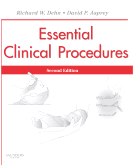|
|
|
| |
 |
|
|

|
 推薦指數:
推薦指數:





|
|
- 內容介紹
|
Essential Clinical Procedures, 2nd Edition
By Richard W. Dehn, MPA, PA-C and David P. Asprey, PhD, PA-C
592 pages 321 ills
Trim size 7 1/2 X 9 1/4 in
Copyright 2007
Description
Written by foremost experts in the field, the 2nd Edition of this concise, well-organized text presents the latest common diagnostic and treatment-related procedures that you need to know. Its clear and concise hands-on guidance takes you step by step through the “how-to’s” of more than 70 procedures. You’ll also find important information on what needs to be done before and immediately following a procedure. It also provides the background and rationale behind each procedure. A host of supporting information in areas such as patient education, informed consent, billing, and delivering bad news ensures that you have all of the information you need to deliver the best and safest care to your patients.
Reviews
REVIEW OF THE PREVIOUS EDITION: “Congratulations are in order for University of Iowa faculty David Asprey and Richard Dehn...this text is the first clinical procedures text for PAs that has been published, likely filling a need in the clinical education arena. Congratulations to both Asprey and Dehn!”– Physicians Assistant Newsletter
Key Features
Features more than 200 illustrations depicting procedure steps and other important concepts.
Presents information on patient preparation and the use of instruments and materials to help ensure the safe and effective performance of procedures.
Highlights warnings to alert you to specific dangers, and points out what not to do when performing a procedure.
Includes guidance on possible complications, rationales, and precautions to provide an overview of the “why,” and not just the “how,” of procedures.
Covers nonprocedural issues including informed consent, standard precautions, patient education, and procedure documentation.
New to this Edition
Offers comprehensive updates throughout to incorporate new procedures and practices.
Features new chapters on removing Cerumen foreign bodies from the ear * corneal abrasion and foreign body removal from the eye * endometrial biopsy * diabetic foot care * conscious sedation * ambulatory care billing and coding * and delivering bad news
Table of Contents
1. Informed Consent
2. Standard Precautions
3. Sterile Technique
4. Blood Pressure Measurement
5. Venipuncture
6. Obtaining Blood Cultures
7. Inserting Intravenous Catheters
8. Arterial Puncture
9. Injections
10. Recording an Electrocardiogram
11. Exercise Stress Testing for the Primary Care Provider
12. Endotracheal Intubation
13. Office Pulmonary Function Testing
14. Nasogastric Tube Placement
15. Lumbar Puncture
16. Urinary Bladder Catheterization
17. Clinical Breast Examination
18. The Pelvic Examination and Obtaining a Routine Papanicolaou’s Smear
19. Examination of the Male Genitalia
20. Joint and Bursal Aspiration
21. Casting and Splinting
22. Local Anesthesia
23. Wound Closure
24. Dermatologic Procedures
25. Incision and Drainage of an Abscess
26. Wound Dressing Techniques
27. Cryosurgery
28. Treating Ingrown Toenails
29. Draining Subungual Hematomas
30. Anoscopy
31. Flexible Sigmoidoscopy
32. Removal of Cerumen and Foreign Bodies from the Ear
33. Corneal Abrasion and Ocular Foreign Body Removal
34. Endometrial Biopsy
35. Foot Examination of the Diabetic Patient
36. Procedural Sedation
37. Patient Education Concepts
38. Outpatient Coding
39. Documentation
40. Giving Sad and Bad News
|
|
|

